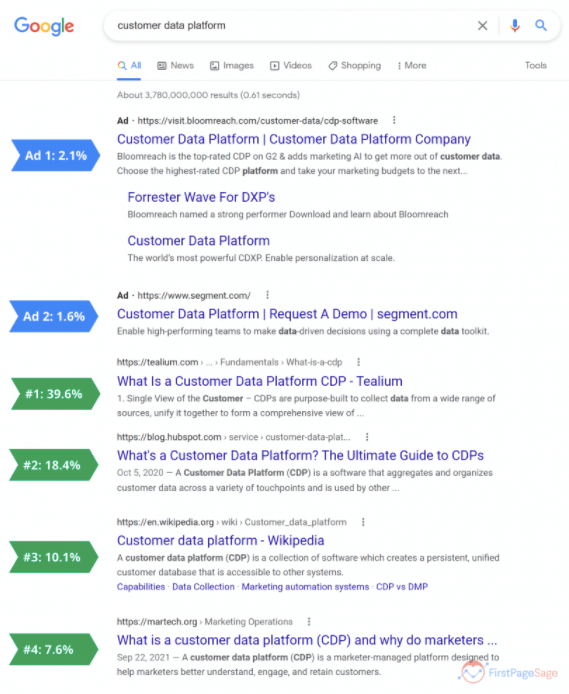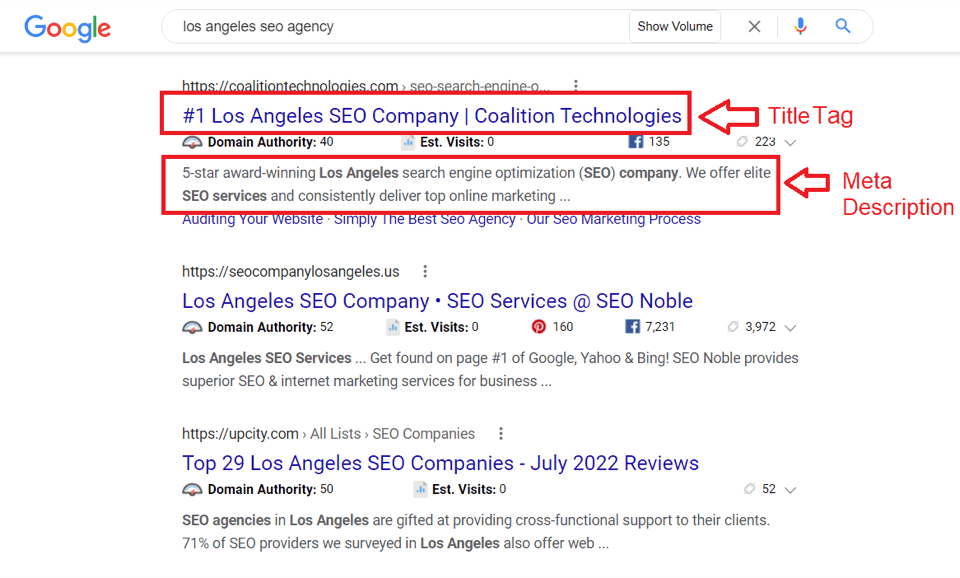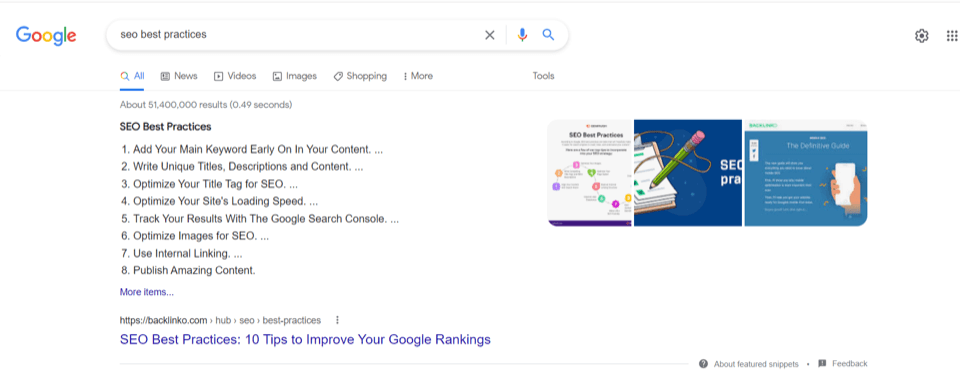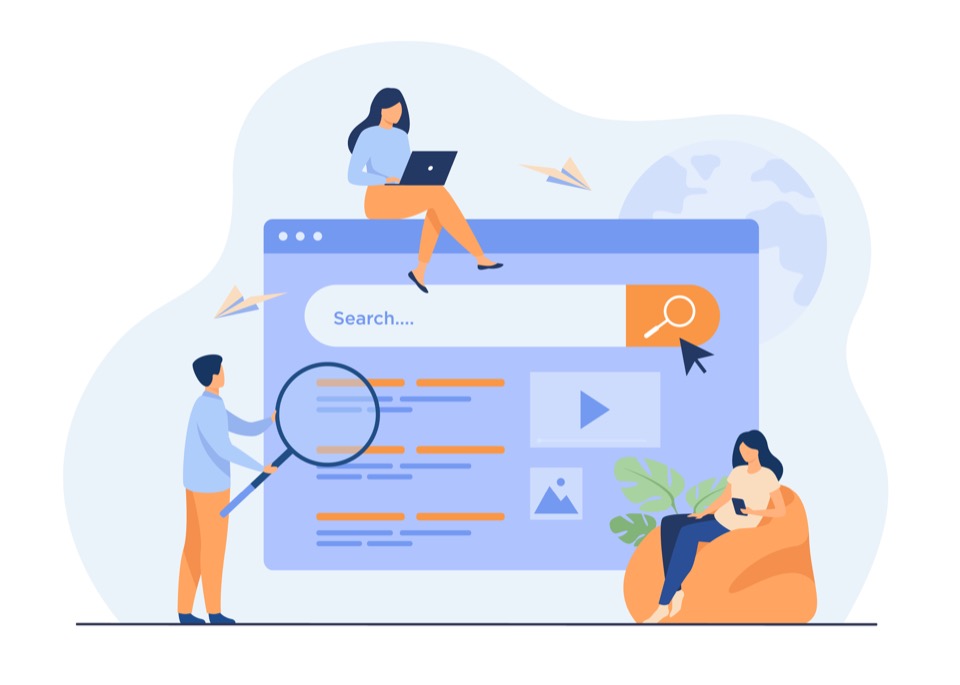There’s no doubt that SEO (Search Engine Optimization) is one of the most important aspects of any online marketing strategy. If you’re not doing everything you can to optimize your website and content for search engines, you’re missing out on a lot of potential traffic. In fact, 68.1% of search engine traffic goes to the top three results.

Most people who are trying to improve their website’s SEO rankings are not sure where to start. That’s mainly because there are a lot of conflicting tips and information out there when it comes to SEO.
Some websites say to solely focus on guest blogging, while others say you need to hit some magical number of published articles before you can get traffic. This makes it a challenge to know which strategies will actually work for your website.
Luckily, we’ve cut through the noise and put together a list of 11 SEO tips that are sure to help improve your website’s ranking based on factors that actually matter. Following the strategies below, you can start seeing instant results when it comes to improving your rankings and getting more traffic from Google and other search engines.
Why Focus On SEO in 2022?
SEO is more important than ever in 2022. As search engines continue to evolve, the importance of optimizing your website and content for search engines will only grow. If you look at the numbers, most people seem to miss the mark on this. According to a study by Ahrefs, less than 10% of websites even get any traffic. The rest get zero, zilch, nada! That makes the potential for focusing on SEO monumental for most businesses.
Focusing on SEO generates 1000% more traffic than social media and is known to outperform other forms of marketing. This is especially true if you consider your return on investment (ROI).
1. Take a Humans-First Approach to Quality Content
Quality content is the key to getting organic search traffic. This means that you need to produce content that is interesting, engaging, and provides value for your readers. If people are not interested in what you have to say, they will not stick around long enough to convert into customers or clients. This is why it’s important to focus on creating quality content that will keep people coming back for more.
Taking a humans-first approach to creating content is imperative. If you’re writing solely with the intent of getting traffic, but you’re just not connecting with your readers, then when the traffic eventually comes, it will all be in vain.
You need to appeal to the people first with evergreen content— content that is original, unique, and fresh.

That being said, here are some things to keep in mind when creating quality content:
- Write for your audience, not for search engines
- Make sure your content is well-researched and accurate
- Use easy-to-understand language
- Keep your content updated and relevant
- Add new content regularly
- Focus on original, evergreen content
2. Target Relevant Keywords & Place Them Strategically
Keywords are the bread and butter of SEO. By targeting relevant keywords, you can make sure that your website and content are being seen by people who are actually interested in what you have to say. This is one of the most crucial steps in improving your SEO rankings.
The first step is to come up with a list of potential keywords that you want to target. To do this, you can use a free or paid keyword research tool to assist you.
Once you have a list of potential keywords, the next step is to place them strategically throughout your website and content. There are two types of keywords: primary and secondary. Primary keywords are the ones that you focus on most because they are related to what you are writing about. Secondary keywords are ones that you also want to include, but you don’t focus on as much as the primary ones.
Google uses something called Bidirectional Encoder Representations from Transformers or BERT to recognize natural language that is contextual to your topic. This means that you should focus on using long-tail keywords or phrases that are conversational and natural.
In other words, write like you’re talking to a human being.
Here are some places to include keywords:
- Title tags
- Meta descriptions
- URL slugs
- Headings (H1 tags)
- Subheadings
- Introductory sentences
- Concluding paragraphs
- Anchor text
3. Optimize Your Metadata
Metadata is the information that appears on your website and tells search engines what your website and pages are about. This includes things like title tags, meta descriptions, and alt text.
Title tags are the most important piece of metadata because they appear on the search engine results pages (SERPs). A title tag is what appears in the clickable link on the SERPs.
A meta description is a short description of your page that appears below the title tag. It’s important to write meta descriptions that are compelling and entice people to click through to your website.

Alt text is the text that appears when an image doesn’t load. It’s important to include keywords in your alt text so that your images can be found in image searches.
To optimize your metadata, make sure that you:
- Include keywords in your title tags and meta descriptions
- Keep your title tags under 60 characters
- Keep your meta descriptions under 160 characters
- Use alt text for all images and include keywords
- Write compelling meta descriptions that make people want to click through to your website
By understanding how to optimize your metadata, you can make sure that you improve SEO rankings and gain traffic for your website. Keep in mind this is the first thing that people see before deciding to visit your page or not.
4. Target Featured Snippets to Get More Real Estate on SERPs
Featured snippets are a way for websites to get more real estate on the search engine results pages. When you appear as a featured snippet, your website will be at the top of the page, and it will have a different look than the other results.

There are many different types of featured snippets that can show up depending on the search query, but they all have one thing in common. They get more traffic. So it’s definitely worth optimizing your website and content in order to secure featured snippets.
How do you optimize for featured snippets?
Here are some tips:
- Use keyword-rich titles and headings
- Determine what type of featured snippet you want to target
- Use images and videos to improve your chances
- Answer common questions related to your topic
- Fulfill user intent
It’s worth noting that the vast majority of featured snippets come from pages already ranking in the top 10 results. This is yet another reason for you to learn how to improve your SEO rankings.
5. Continuously Build Backlinks
Another way to improve your rankings is to continuously build backlinks. Building internal and external links to your website are the top SEO ranking factors in 2022.
Internal links are links from one page on your website to another. External links are links from other websites to yours.
Both types of links are important because they show search engines the relationship between your pages. They also help improve the user experience by making it easier for people to navigate your website.
It’s important to link internally from your higher ranking pages that have more page authority to relevant pages that you’re trying to improve. This will help boost important pages in the search engines.
Just as internal linking can help boost internal pages, external linking from high authority websites should be a key focus point of your link building strategy.
To build links, you can:
- Ensure you’re receiving “do follow” links
- Reach out to other website owners and request a link
- Create great content that others will want to link to
- Do guest blogging
- Participate in forums and leave comments with links back to your website
By frequently building links, you can improve the authority of your website and improve your SEO rankings.
6. Understand the Value of User Intent
One thing to consider when understanding how to improve your SEO rankings is user intent. This is something that is commonly overlooked, but it makes a huge impact.
User intent is basically what someone is looking for when they type in a certain search query. There are different types of User Intent, and it’s important to understand them in order to create content that ranks well.
The four main types of user intent are:
- Informational: People are looking to learn something
- Navigational: People are looking for a specific website or page
- Customer Investigation: People conducting research to make a buying decision
- Transactional: People are looking to buy
Google pours loads of money and research into understanding precisely what type of content users want based on their search queries to satisfy user intent.
That being said, if your target keyword doesn’t match the intent of the pages ranking on the SERP, you may consider changing to a keyword that’s a better fit for your content.
Here’s how you can determine the User Intent of your target keyword:
- Do a Google search for your target keyword
- Look at the top-ranking pages
- Determine what type of content is ranking (listicles, how-to’s, product pages, etc.)
- Create similar content to satisfy the same User Intent (or change your keyword)
By understanding how to match the User Intent of your target keyword, you can create content that ranks well and improves your SEO rankings.
7. Fix Page Speed Issues
The speed of your website is one of Google’s 200 SEO ranking factors in 2022. In fact, it’s been a ranking factor for a few years now.
Google wants to give users the best experience possible, and that includes providing them with websites that load quickly. If your website is slow, it will negatively impact your SEO rankings.
There are a few things you can do to improve the speed of your website:
- Use a faster hosting provider
- Optimize your images
- Use a caching plugin
- Minify your code
- Reduce the number of plugins you’re using
- Load JavaScript and CSS asynchronously
By fixing your page speed issues, you can improve your SEO rankings and give users a better experience.
If you’re not sure if page speed is an issue for you, try using Google’s PageSpeed Insights tool or GTmetrix. Just enter your URL, and it will give you a report of how you can improve your page speed.
8. Improve Existing Content & Update Old Pages
One of the best things you can do to improve your SEO rankings is to refine your existing content. This includes updating old blog posts and pages with new information, adding new images, and improving the overall quality of your content.
You can also add more content to existing pages to make them more comprehensive and improve your SEO rankings. This is called “Content Expansion.”
Here are a few things you can do to improve your existing content:
- Add new images
- Update old information
- Add new sections
- Make your content more comprehensive
- Improve the overall quality of your content
By revamping your existing content, you can improve your SEO rankings and drive more traffic to your website.
9. Generate Backlinks from Visual Assets
You can generate backlinks by creating and embedding infographics, images, and other visual assets within your content.
Typically, if someone uses your image, they should link to you. Unfortunately, this isn’t always the case.
So when someone links to the file instead of directly to the source page, they’re not passing along any link juice.

To correct this, try contacting or “nudging” those who have “borrowed” your photo, screenshot, or infographic and ask them to link directly to the source page. This will help improve your SEO rankings by increasing your backlinks and authority.
Here’s how you can get backlinks from images and visual assets:
- Include images, infographics, and other visual assets in your content
- Conduct a Google image search using the exact image link address
- Make a list of those using your image who are not currently linking to you
- Send them an email and ask for a link.
10. Routinely Audit Your Site & Pages
One of the best things you can do for your SEO is to routinely audit your website and pages for any technical issues or missing ranking factors. This will help you identify any problems that could be negatively impacting your SEO rankings.
An audit will also give you a chance to improve your website’s overall health, which is important for your SEO rankings.
Here are a few things you should look for when auditing your website:
- 404 errors
- Broken links
- Duplicate content
- Non-optimized images
- Slow page speed
- Title tags and meta descriptions that are too long or short
- Missing alt text
- Internal linking issues (like orphan pages)
This is also a good opportunity to update, consolidate, or remove outdated pages you may have that are underperforming.
11. Continue Learning SEO
The last tip we’ll leave you with to improve your SEO rankings is to continue learning SEO. The world of SEO is always changing, so it’s important to stay up-to-date with the latest trends and changes.
Here are a few ways to do this:
- Read SEO blogs (like Moz, Search Engine Journal, and Search Engine Land)
- Attend webinars and conferences
- Follow SEO experts
- Study your competitors
- Avoid outdated advice
This will allow you to stay on top of SEO. Of course, this is the DIY method. You can always opt to hire the experts if you’re looking for a done-for-you option.
In either case, it’s important to be somewhat well-versed in the world of SEO so you can make informed decisions about how to improve your rankings.
Conclusion
We hope you found these tips helpful. SEO doesn’t have to be complicated or expensive. By following these simple tips, you can start to see improvements in your SEO rankings and traffic.
Remember, consistency is key.
If you’re looking for more ways to improve your SEO rankings, be sure to check out our blog for more tips and strategies.

